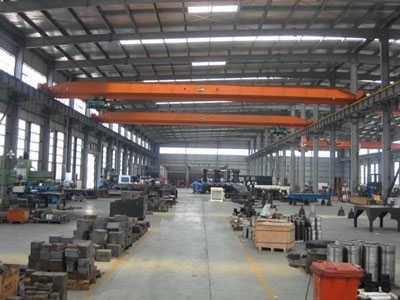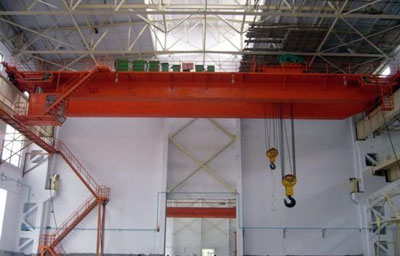Overhead Cranes and Gantry Cranes Rail Gnawing Problems
Overhead crane and gantry crane maintenance cannot be ignored. In the daily use of the cranes, the components will inevitably wear out, the joints will loosen, and the metal structure will corrode, which will cause the overhead crane and gantry crane's use function, economic function, and safety function to varying degrees to decline. Therefore, in order to prevent and eliminate hidden dangers, it is important and necessary to ensure that the crane is always in good condition before the wear of the crane parts has reached the level that affects the failure of the crane.

What is the rail gnawing of overhead cranes and gantry cranes?
Crane rail gnawing is a problem often encountered in actual production. Crane rail gnawing means that during the operation of the crane cart or trolley, a certain gap should be maintained between the wheel rim of the cart or trolley and the side of the track, but the wheel rim and the side contact of the track generate a horizontal lateral thrust, which causes friction and wears on the wheel rim and the track, which is what we call rail gnawing.
Specifically, the judgment and manifestation of crane rail gnawing mainly include the following points:
1. During the bridge crane operation, the car body is skewed, and the wheels are deflected.
2. When the bridge crane is in use, the gap between the wheel rim and the track obviously grows larger or smaller.
3. On the side of the crane track, there is obvious rubbing and bright spots; there are relatively sharp edges and corners on the guide rail; and there are snow-white bright spots on the top of the track.
4. When the crane cart is running, there will be a harsh rail-gnawing sound. When the rail gnawing is serious, the cart will not only produce a harsh noise, but also cause the cart to jump slightly. This is what we often call the “rail climbing phenomenon”.

Hazards of overhead cranes and gantry cranes rail gnawing
Crane rail gnawing is a kind of behavior that is relatively harmful to cranes, and it is also a common situation in crane failures. Many operators do not pay enough attention, so the problem of rail gnawing occurs from time to time. Specifically, rail gnawing will pose the following hazards to the crane:
1. Wear track
In the event of rail gnawing, the wheels and rails are in rigid contact, which will aggravate the wear of the rails to a certain extent. With the increase in wear, the stability of the crane's large and small vehicles will decrease, which will seriously affect the safety of the crane.
2. Reduce the service life of the wheel
Because the material of the wheel of the crane is usually cast steel after quenching and other processes, it can basically be used for more than 10 years. However, due to the problem of rail gnawing, the life of the wheel will be greatly reduced, which will seriously affect the production efficiency.
3. Affect the structure of the factory building
Because when the crane gnaws on the rail, it will make noise and cause vibration, and when the crane is running, it will generate horizontal lateral force, which will cause the crane to generate abnormal vibration, which will cause the plant structure to vibrate and be damaged to a certain extent.
4. Risk of derailment
When the wheels or tracks are severely worn, the wheels may climb to the top surface of the track, causing the cart or trolley to derail, thereby causing a safety accident.

Inspection cycle of lifting machinery (overhead cranes and gantry cranes)
Generally, hoisting machinery has an inspection cycle. In order to better maintain the crane equipment and achieve better use results, the current government-specified periodic inspection cycle for hoisting machinery is as follows:
1. Overhead cranes, gantry cranes, light and small lifting equipment, gantry cranes, jib cranes, railway cranes, and mechanical parking equipment must be inspected once every two years, among which cranes for lifting molten metal and hot metal need to be inspected once a year.
2. The tire-type container gantry crane should be inspected once every 2 years.
During the crane inspection process, for cranes that do have major hidden dangers (such as frequent accidents, a special operating environment, etc.), the inspection agency may appropriately shorten the periodic inspection cycle after reporting to the provincial quality and technical supervision department for approval, but the inspection period cannot be less than 6 months.
In addition, the static load test, rated load test, and dynamic load test items in the performance test must be carried out during the periodic inspection, and the rated load test item must be carried out once every inspection cycle thereafter.
The above are the relevant regulations on the inspection cycle of hoisting machinery. Regular inspection is not only to comply with the regulations but also to discover hidden dangers of cranes as soon as possible, avoid major accidents, and be more conducive to production safety.
Overhead cranes and gantry cranes are our main products, if you have a need for them, pleasecontact us freely.
- The last one:Advantages and Structural Characteristics of European Cranes
- The next one:Dirt Cleaning After Use of Electric Hoists
 info@dejunindustry.com
info@dejunindustry.com +86 13721448067
+86 13721448067




